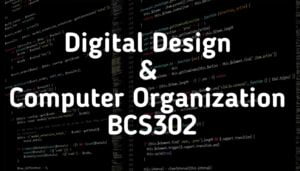
Digital Design and Computer Organization BCS302
Module 1`
Introduction to Digital Design: Binary Logic, Basic Theorems And Properties Of Boolean Algebra,
Boolean Functions, Digital Logic Gates, Introduction, The Map Method, Four-Variable Map, Don’t-Care Conditions, NAND and NOR Implementation, Other Hardware Description Language Verilog Model of a simple circuit.
Module 2
Combinational Logic: Introduction, Combinational Circuits, Design Procedure, Binary Adder- Subtractor Decoders, Encoders, Multiplexers. HDL Models of Combinational Circuits – Adder, Multiplexer, Encoder. Sequential Logic: Introduction, Sequential Circuits, Storage Elements: Latches, Flip-Flops.
Module 3
Basic Structure of Computers: Functional Units, Basic Operational Concepts, Bus structure, Performance –Processor Clock, Basic Performance Equation, Clock Rate, Performance Measurement.Machine Instructions and Programs: Memory Location and Addresses, Memory Operations, Instruction and Instruction sequencing, Addressing Modes.
Module 4
Input/output Organization: Accessing I/O Devices, Interrupts – Interrupt Hardware, Enabling and Disabling Interrupts, Handling Multiple Devices, Direct Memory Access: Bus Arbitration, Speed, size and Cost of memory systems. Cache Memories – Mapping Functions.
Module 5
Basic Processing Unit: Some Fundamental Concepts: Register Transfers, Performing ALU operations, fetching a word from Memory, Storing a word in memory. Execution of a Complete Instruction. Pipelining: Basic concepts, Role of Cache memory, Pipeline Performance.
It’s hard to find experienced people about this topic, but you sound like you know what you’re talking about! Thanks
I was able to find good info from your blog articles.
Howdy! I just would like to give you a big thumbs up for the excellent info you have got here on this post. I will be returning to your blog for more soon.
Very interesting topic, thank you for putting up..
As soon as I discovered this internet site I went on reddit to share
some of the love with them. Escape room lista